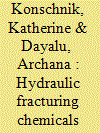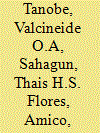|
|
|
Sort Order |
|
|
|
Items / Page
|
|
|
|
|
|
|
| Srl | Item |
| 1 |
ID:
150394


|
|
|
|
|
| Summary/Abstract |
Twenty-eight states require disclosure of hydraulic fracturing chemicals. Twenty-three states direct reporting to FracFocus; additionally, companies in other states use this registry. FracFocus contains the most comprehensive dataset on fracturing chemicals but faces data quality and transparency criticisms. In response, FracFocus announced upgrades, and since May 2015, publishes aggregated data. We used Linux and R version 3.2.0 to clean and analyze 96,449 forms submitted between March 9, 2011 and April 13, 2015 for accuracy, completeness, and timeliness. We characterize data, and compare results to state law and industry practice, to suggest how to induce more accurate and complete disclosures. We find that rates of withheld chemical information have increased since 2013, and appear unaffected by different legal requirements. However, when companies report fracturing chemicals without attribution to the specific products in the fracturing fluid (a “systems approach” to reporting), withholding rates drop four-fold. State deadlines shortened reporting timelines, but compliance rates are low absent indication states will enforce. Automatic field population and prompts in FracFocus can reduce data error, while enforcement signals, education, and harmonized requirements may boost compliance and enhance disclosure. Systems reporting should occur, with states retaining authority to request product-specific ingredient lists.
|
|
|
|
|
|
|
|
|
|
|
|
|
|
|
|
| 2 |
ID:
130713


|
|
|
|
|
| Publication |
2014.
|
| Summary/Abstract |
There is an increasing demand for designing controlled drug delivery systems with materials which are morebiocompatible, economical and materials which can be processed easily. Poly (vinyl alcohol) (PVA) and hyaluronic acid (HA) are promising polymers for applications in drug delivery. PVA forms gel based on the acetal bridges when cross linked with glutar aldehyde (GA). On the other hand, HA a natural polymer, forms gel with divinyl sulfone(DVS) as a cross linker. PVA and HA blends upon crosslinking PVA with GA or HA with DVS, in the presence of the other polymer, form gels that are more adaptable to the drug delivery systems. In this work, the mechanical properties and swelling behaviour of PVAHA gels were characterized. The effect of composition on visco elasticmoduli and degree of swelling was determined. The storage modulus (G?) of various gels made of PVA, HA and PVAHA blends were measured using rheology and compared with the values available in the literature. Swelling properties were measured and compared among various PVA and HA gels. Collagen is added to PVA solution and the rheological properties were measured in the gel state. Based on the values of storage modulus, gels of various compositions of PVA, HA and collagen might be selected as potential biomaterials for drug delivery system depending on careful understanding the type of application.
|
|
|
|
|
|
|
|
|
|
|
|
|
|
|
|
| 3 |
ID:
130737


|
|
|
|
|
| Publication |
2014.
|
| Summary/Abstract |
Increasing environmental concern along with the drive to find substitutes for synthetic fibers and value added applications for low cost and renewable plant fibers have led to the development of composites based on biomaterials. One of the drawbacks encountered in such exercise is the lack of adhesion between the incorporated plant fibers and synthetic polymeric matrices. Such drawback can be reduced by appropriate treatment of fibers. This paper describes the chemical treatments used on sponge gourd (Luffa cylindrica) fibers of Brazil to prepare their composites with polyester resin. Production of short fiber-polymer composite as well as mat-polyester composites is presented here. Characterization of the composites in respect of evaluation of density, water absorption, thermalstability, tensile properties and impact strength were made and the results are discussed. Observed impact strengthand tensile properties are discussed based on the fractographic studies of the composites.
|
|
|
|
|
|
|
|
|
|
|
|
|
|
|
|
|
|
|
|
|